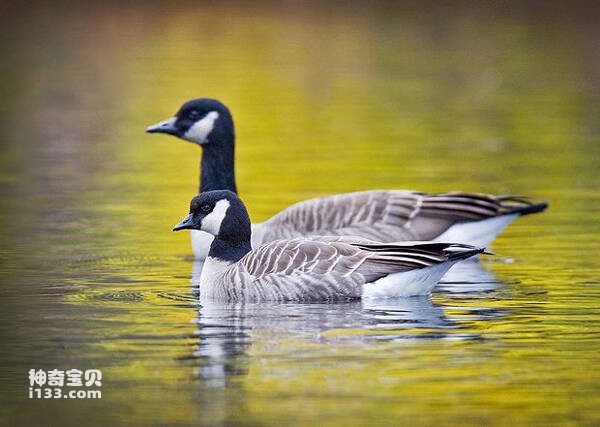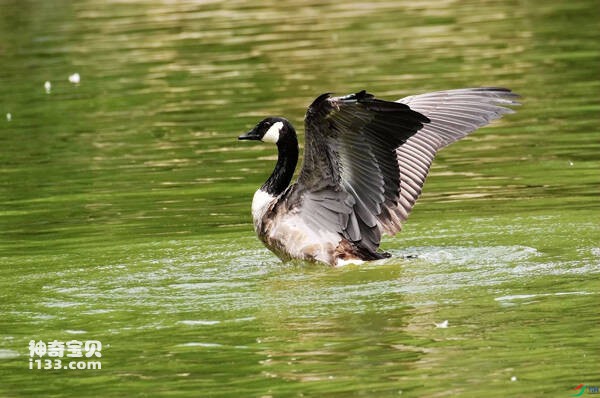Branta canadensis
IUCN
LCBasic Information
Scientific classification
- name:Branta canadensis
- Scientific Name:Branta canadensis,Canada Goose
- Outline:Waterfowl
- Family:
Vital signs
- length:About 100 cm
- Weight:3-10.9kg
- lifetime:About 24 years
Feature
It is the largest anechelon species in the world
Distribution and Habitat
The species is widely distributed, breeding in the tundra of Canada, Alaska, most of the United States, and parts of the northern United States, and wintering in southern North America, including Mexico. Alien populations reside in most areas south of the normal breeding range in the United States, as well as in many Western European countries. The Asian subspecies, which occurs in the Bering Sea region, has been extinct since about 1914.
It inhabits bays, harbours and estuaries, or on low grassy slopes near the coast. It is found mainly in tundra lowlands along the Arctic coast, usually not far from the sea tides, especially in tundra plains divided by many tidal streams, usually only a few kilometers from the highest tidal line. Sometimes they also extend from coastal tidal zones to grassy inland tundra lakes and grassy lake islands. Habitat during the breeding season is mainly tundra or shrubbery tundra covered with moss and lichen, especially in higher and drier parts of the tun
Appearance
The Canadian Barnacle is the world's largest species of barnacle. The species has a lesser degree of sexual dimorphism, in which males are slightly larger than females, but both weigh between 3-10.9 kg. It is 76-110 cm tall and has a wingspan of 1.3-1.7 m. Although the differences between the sexes are small, they look similar. The head and neck are long, the back has varying shades of brown-gray plumage, and the belly and rump are usually milky or white. The head and neck are black, and the throat extends to the throat with obvious white stripes. The tail is short, black, with white covering on the tail. Underbelly and undertail coverts white. There are seven subspecies, distinguished by differences in the head, the size and location of the white spots, and the grayness of the plumage on the body. Of the seven subspecies, the largest is the named subspecies of the Canadian Barnacle goose, which usually weighs about 6.4 kg. It has a black beak and feet. Birds have thin, comb-like
Details
The Canadian Barnacle Goose (Branta canadensis) is known as Canada Goose. According to the American Ornithologists Union (2004), In 2014, Branta canadensis was split into B. canadensis and B. hutchinsii, with 7 and 5 subspecies, respectively.

Canada barnacle geese feed mainly on plant foods. When they first move to their breeding grounds, they feed mainly on moss and lichen beneath the rocks because the ice and snow have not melted. As temperatures rise and the plants begin to shade, they begin to forage in abundance for regrowing shoots, stems and leaves. In autumn and winter, they forage for eelwort and seaweed along the coast, and occasionally feed on small amounts of aquatic insects, mollusks, small crustaceans, and other aquatic invertebrates and fish eggs. They feed mainly in the early morning and afternoon. The breeding season mainly feeds on tundra ground, and the non-breeding season feeds on coastal and coastal mud. Feeding methods In addition to the general head and neck into the water to feed, they can also like some ducks in shallow water, tail up into the water to feed on the bottom.

Canada barns breed from mid-March to the end of August in the spring. The nest is made of hay, etc., with some feathering in it. Each clutch lays 4-7 eggs. The eggs are white and yellowish white. The female geese incubate the eggs alone, and the male geese act as a guard near the nest during the period of laying and incubating. When female geese leave the nest to forage, they cover it with feathers and grass near the nest. If an intruder comes, the goose will call loudly, sound anxious, and assume a threatening posture, and sometimes even make a posture of preparing to attack the intruder without abandoning the nest. Incubation period is 25-30 days. The young geese have been feathered after hatching and belong to the early mature geese. When the young goose hatches, the male goose also joins in the care and protection of the young goose, together with the female goose to lead the young goose to forage in the dense vegetation, the parent bird takes care of the young bird for 40 to 73 days. From late July to early August, mature geese begin to molt, which takes about 15-20 days. It takes 2-3 years for young geese to reach sexual maturity.
The Canadian barnacle has a wide range and the global species population is estimated at an average of 5,000,000 to 6,200,000 (Wetlands International 2015). The European population is estimated at 1,000-5,000 pairs, equivalent to 2,000-10,000 mature individuals (BirdLife International 2015).

Us Airways Flight 1549 forced landing: On January 15, 2009, US Airways Flight 1549 lost power after being struck by a flock of Canadian barnants during its ascent, and the pilot decided to make an emergency landing in the Hudson River after determining that he could not reach any nearby airports. The flight made an emergency landing on the Hudson River in Midtown Manhattan six minutes after takeoff. All 151 people on board survived in what is known as the "Miracle on the Hudson" or "Miracle on the Hudson".
Listed on the International Union for Conservation of Nature Red List of Threatened Species (IUCN) 2018 ver 3.1 - Not Threatened (LC).
Protect wild animals and eliminate wild meat.
Maintaining ecological balance is everyone's responsibility!








